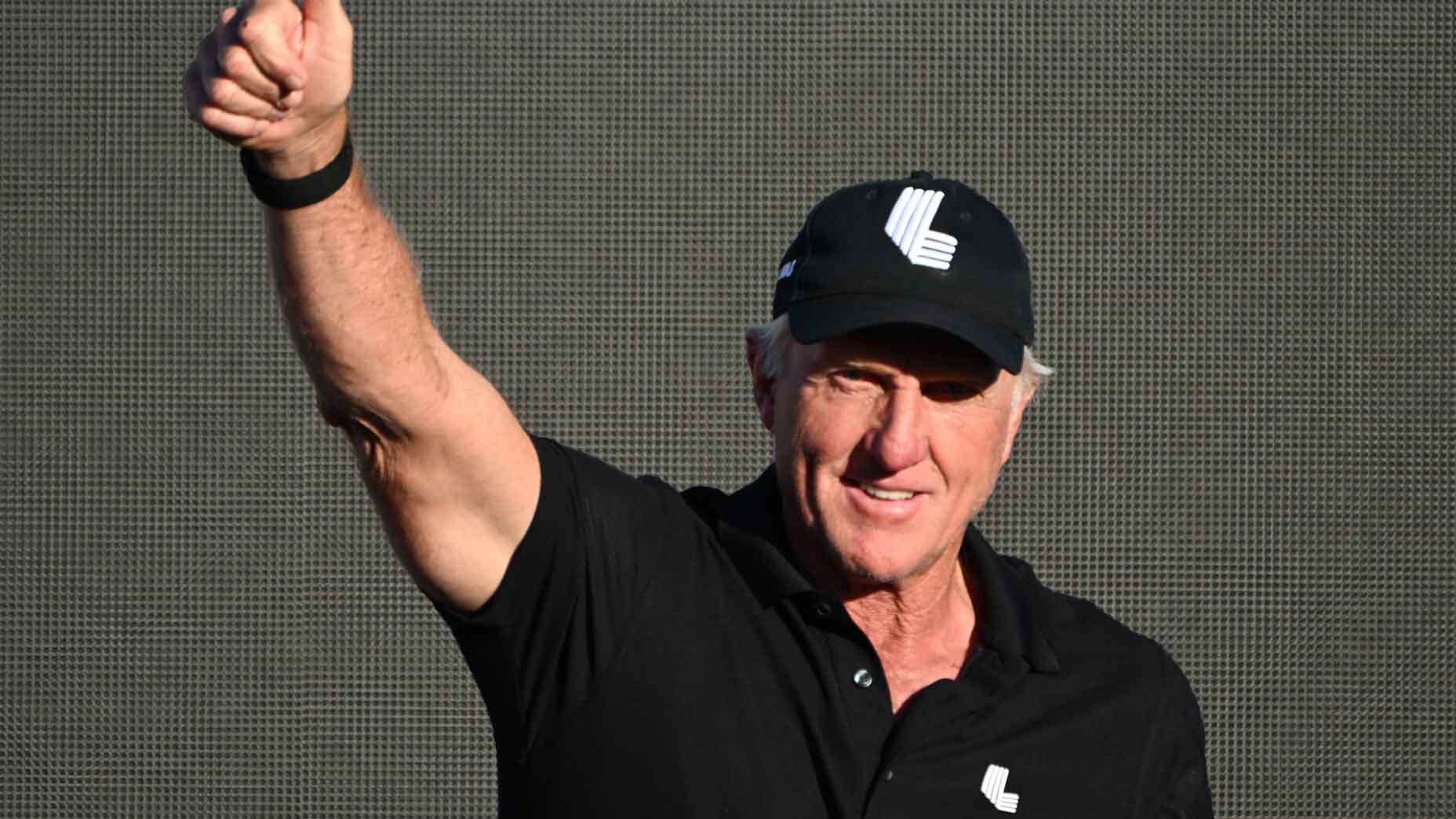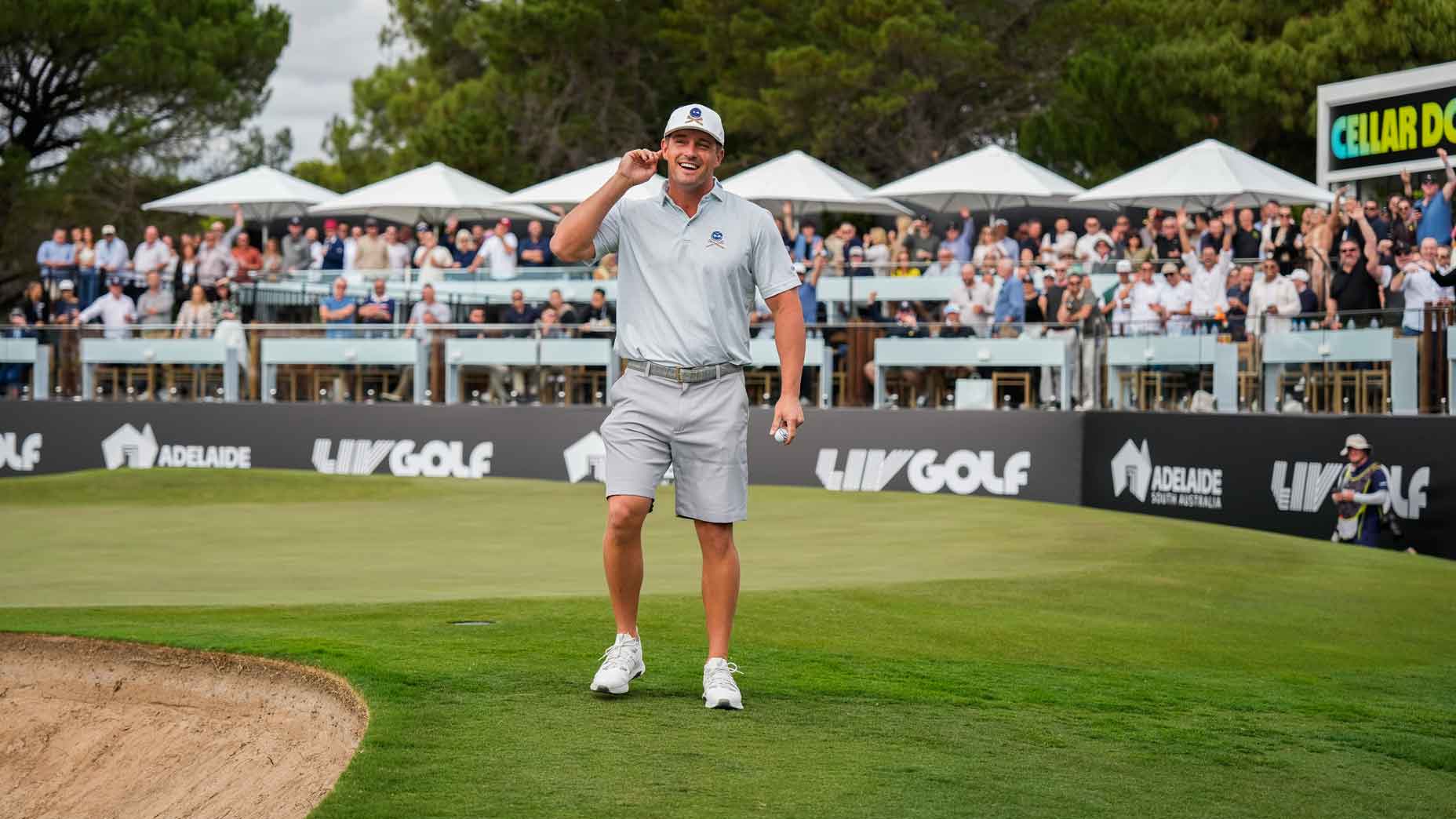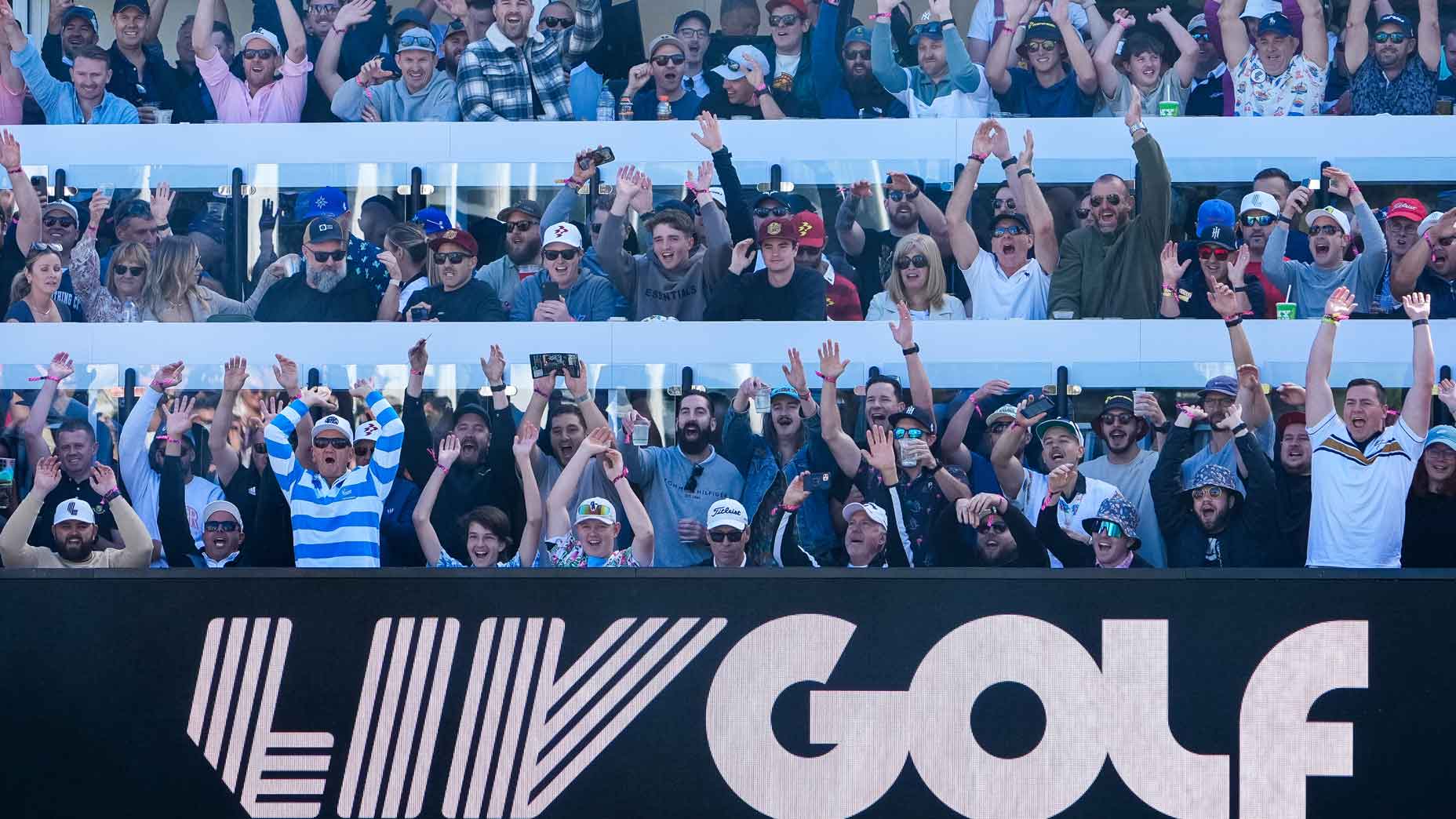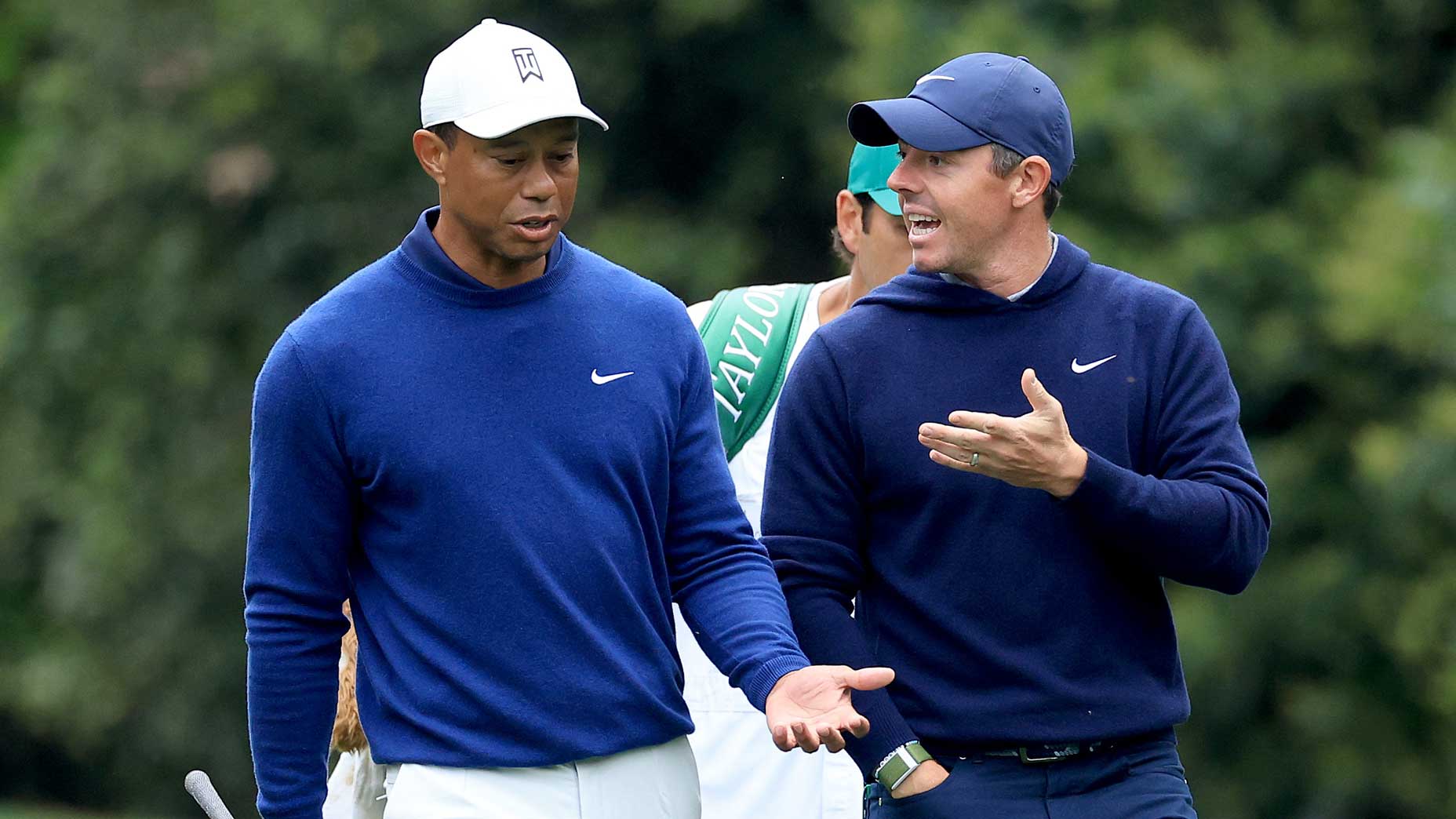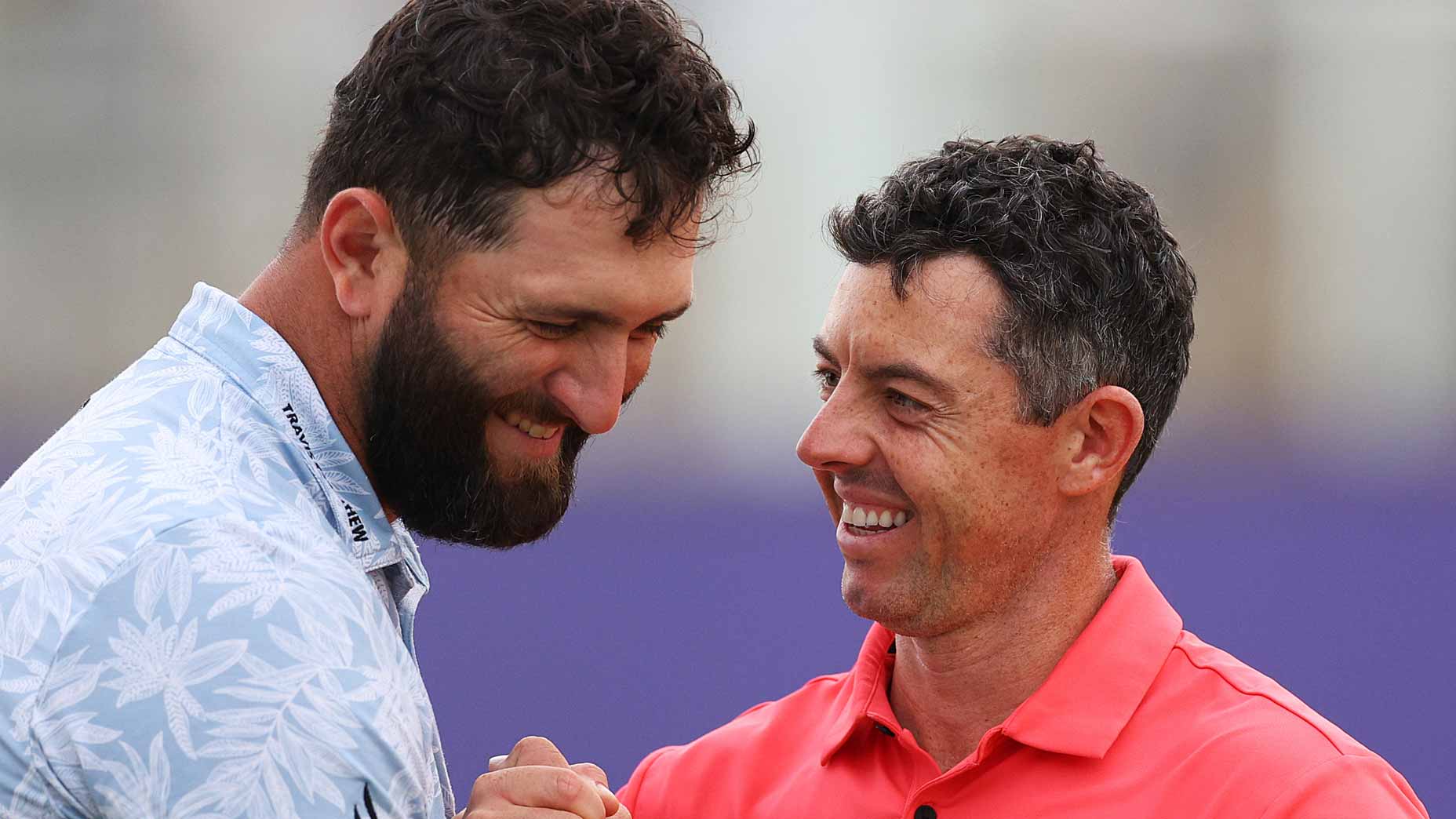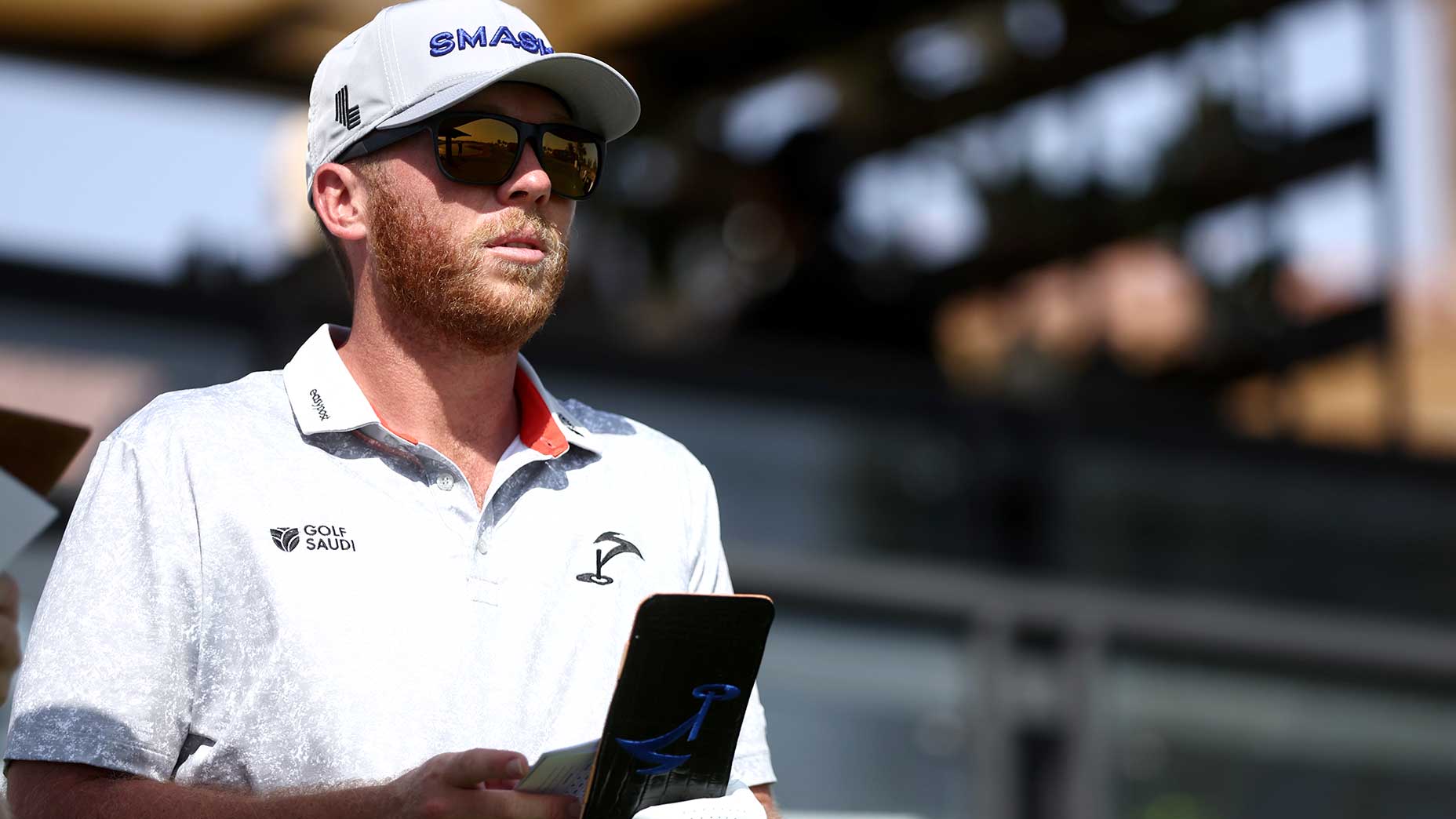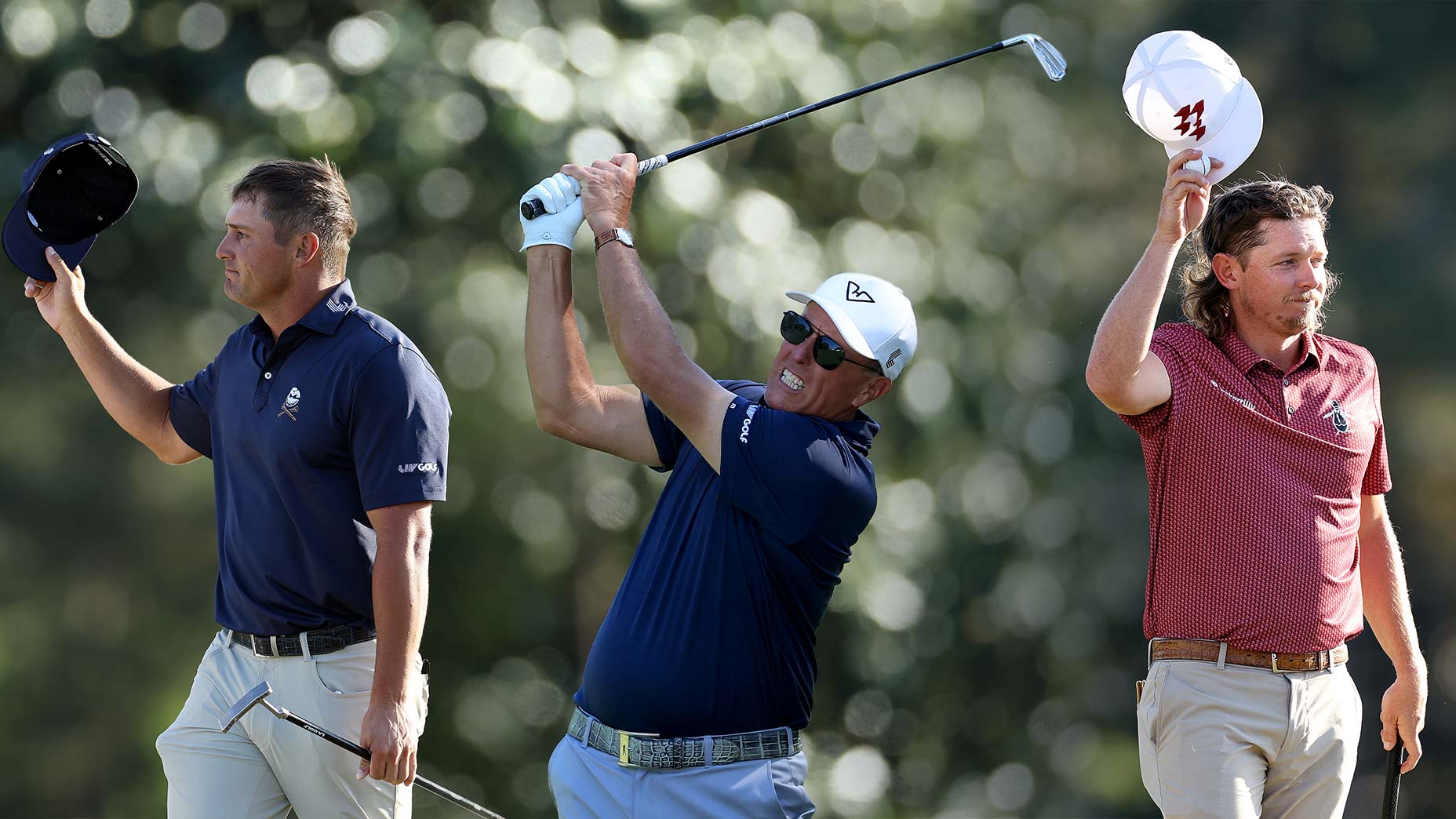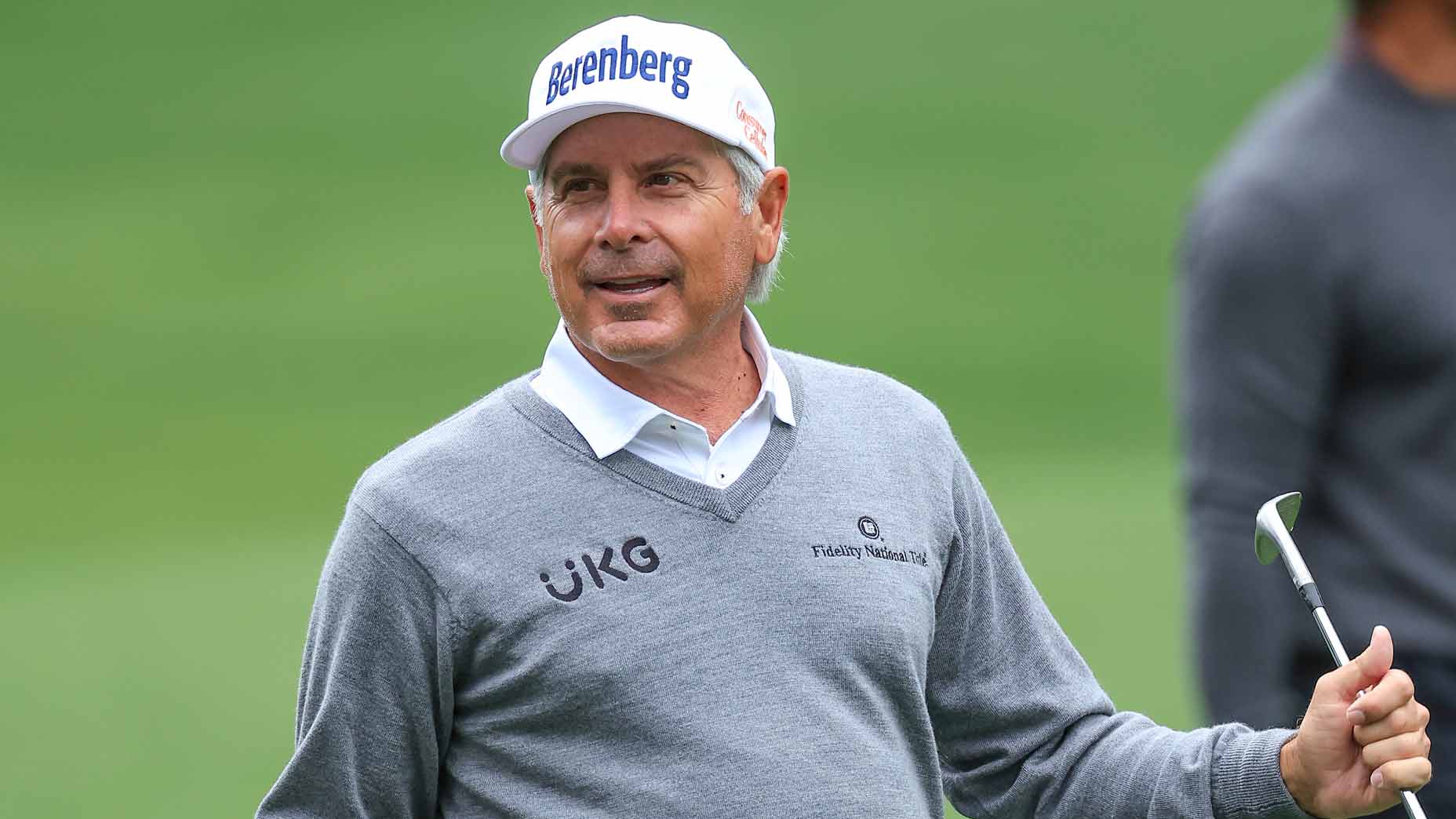Inside the night LIV Golf was born: What the player draft was really like

Dustin Johnson walks across the stage during LIV Golf's player draft in 2022.
Getty Images
LIV Golf launched 22 months ago, on a warm summer night in London. The location? A glitzy new studio shoehorned into the corner of an office park. It was the first (and only) player draft LIV ever hosted, and it did not lack for flash.
The professional golf landscape has changed so much in the nearly two years since. But the eve of LIV’s return to the U.S. — LIV’s Miami event begins Friday — felt like an apt time to revisit the moment the tour launched. The night everything got real. This is what it was like inside LIV Golf’s player draft.
The account below is an excerpt adapted from the new book, “Searching in St. Andrews,” by GOLF senior writer Sean Zak. It is reprinted here with the permission of Triumph Books.
——–
It’s not exactly clear when, but in the days preceding it’s player draft, LIV Golf pivoted from being pro-media to prohibiting media. It wasn’t explained to the journalists at the golf course, many of whom asked to cover the event, but you could literally see the indecisiveness on the walls at the draft party.
Signs at each doorway displayed a legend of colored wristbands for security to monitor. Commissioner Greg Norman’s wristband was grey. Orange bands were guest services, red bands were for security. Black bands were players, white bands were captains. There were 10 distinctions in all, and media wristbands were yellow, but no yellow bands were handed out that night. I can’t say definitively why a league thirsty for media coverage suddenly got skittish about reporters covering its draft, but based on that morning’s press conferences, it wasn’t surprising.
During the first set of LIV pressers, there was a battering of questions about Saudi Arabia’s human rights record. Players were asked about their decision to take “blood money,” and the potential to be banned from the PGA Tour or — even worse — miss out on major championships. Every player had received strict media training and talking points to adhere to whenever Saudi Arabia, suspensions, or money was brought up.
Louis Oosthuizen was first to speak, raving about the chance to do something different. Dustin Johnson highlighted the team golf format and how it would be “great for the fans.” They were both talking on message. Graeme McDowell followed suit, if only for a few minutes, but eventually, his sensibilities snapped and he said the quiet part out loud: “We are professional golfers. If Saudi Arabia wanted to use the game of golf as a way for them to get to where they want to be and they have the resources to accelerate that experience, I think we are proud to help them on that journey using the game of golf and the abilities that we have to help grow the sport and take them to where they want to be.”
These answers were truly the first of their kind, and even if they mostly lacked nuance, they were the first chance for players to explain their side to this story. McDowell’s story, even if he didn’t seem to realize it, is basically a word-for-word definition of sportswashing. That he was willing to say it out loud and invoke the country’s name and imply misgivings was more than we were getting elsewhere. Almost immediately G-Mac was roasted online for this transparency, but the whole act of this press conference was worthwhile. We ask the questions, they answer. The rest of the world is the jury.
Two hours later, at the end of the second presser, an AP reporter named Rob Harris pleaded with LIV staff to get one more question in. LIV had promised 30-minute press conferences but was wrapping this one around the 25-minute mark. When Harris’ request wasn’t granted and Kevin Na and Co. began to leave their seats, Harris leapt from his own, confronting players at the dais. He shouted a question about “blood money” as players awkwardly retreated from the podium. Security confronted him and promptly removed Harris from the media center, an ordeal that was wiped from LIV Golf’s archival video. Fellow writers explained later that Harris’ actions were toeing the line if not blatantly crossing it. But even as he was allowed to return minutes later, an unintentional statement of sorts had been made from Day 1: a writer was dragged out of LIV Golf ’s media center. Details of the incident whizzed across social media.
The draft hovered in the wake of this. Anyone on the guest list had exactly one afternoon of coverage to react to. The sacrificial players who had faced the initial interrogations were off the hook, at least until Thursday’s opening round. The others were learning what they were in for, literally, over cocktails. Sergio García dipped into a yogurty hors d’oeuvre as he soothed Jane MacNeille, the LIV staffer who met the brunt of Harris’ fire. García told her not to worry, “There are just bad people in this world.” The irony of his words was clearly lost on him. This Day 1 checkpoint was clearly a safe space for everyone, especially without media crawling around. Everyone there wanted to be there, at RD Studios, a boxy, state-of-the-art event space in London. It had opened just weeks before LIV arrived.
From the outside, the setup felt conspicuous. Event security extended about 100 yards out from the gate, along the fences of a DHL shipping warehouse. It felt odd that this flashy new league was launching in an office park next to a Bestway, the British equivalent of Costco. The VIP guest list was about 10 pages long and included everyone from Lee Westwood to Claude Harmon to Eric Trump (though he did not attend, best I could tell). I had secured one of two media invitations.
When LIV first launched its ticket service in late April, access to events like this one was also for sale. A one-day grounds pass to the tournament went for $85 and hospitality seats for $310. But VIP access to the draft party could be had for $1,500. Sticker shock aside, the business plan made sense. Push all your high-priced LIV golfers into the same room, hand out free drinks with lobster rolls, and fans would pony up to rub elbows with their favorite pros. Only LIV was struggling so hard to get people to simply attend the tournament rounds that it was essentially giving tickets away for free with discount codes. If they couldn’t get fans to pay $85 to watch the golf, $1,500 to watch players get drafted was out of the question.
Given the price tag, it was no surprise that the first draft was overly gaudy. Upon arrival guests posed for photos in front of a LIV banner as if this were the Academy Awards. And in fairness, they were walking along a 200-foot red carpet toward the action. Various props were located nearby, with LIV’s logo emblazoned everywhere: on director’s chairs and megaphones and a radio studio sign lit up in red reading LIV On Air. “Golf, But Louder” was the official slogan, and this was as visually loud as it gets. I trailed behind 20-year-old, uber-talented amateur David Puig, who had arrived just days after competing in the NCAA Championship at Arizona State. He wore an untucked white button-down over some blue jeans and Stan Smiths. We walked down a narrow corridor lined with fluorescent lights and overstaffed by workers in formal attire. House music thumped from a room around the corner, where disco lights flickered in every direction. It had the feel of a European night club, which made even more sense when I found myself chest-to-chest with a bouncer protecting the official draft room, dubbed Studio 54. Tucked back in the corner, deep in the belly of RD Studios, most of the guests gathered in a room named The 19th Hole. That’s where the disco lights streamed from, calling you inward.
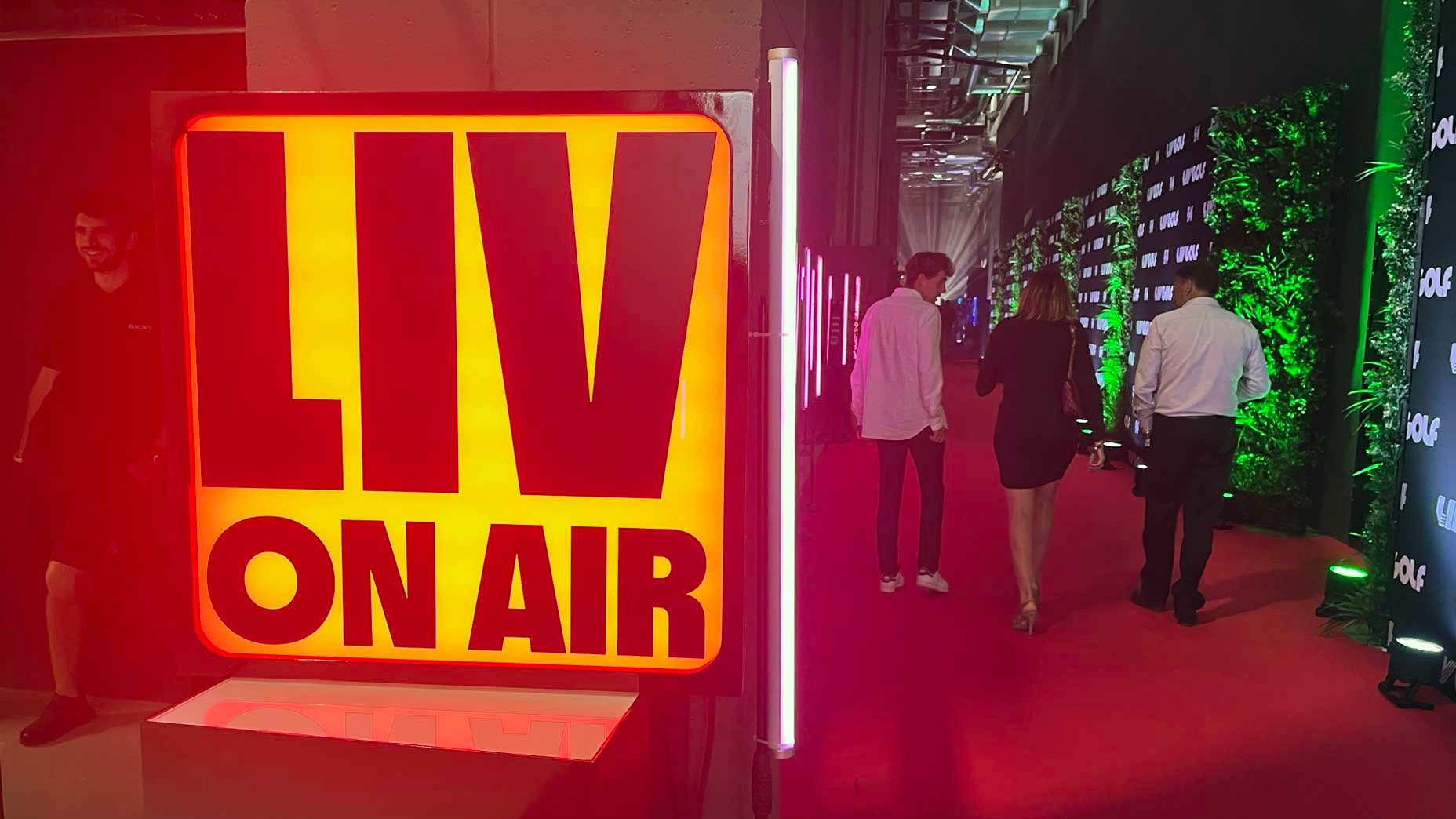
This rectangular cave was packed shoulder to shoulder, if for no other reason than it was physically small: just 3,150 square feet, with a central bar around which the guests mingled. Chase Koepka, the kid brother of world-famous Brooks Koepka, was the first pro I spotted, milling around in an untucked dress shirt. Claude Harmon was next, one of the game’s most popular coaches, peering down at his phone while a bartender mixed him a drink. Ian Poulter and Graeme McDowell had cleaned up into cocktail attire. On the far side of The 19th Hole was the most decadent spread of British seafood I had ever seen. Smoked salmon plucked from the nearby River Severn, about 100 miles west. Tuna tartare served with shallots and sour cream. (I salivate once again just writing about it.) LIV was putting on a party and doing the specifics really well.
The irony in this room may not have been clear to everyone in attendance, but it was to me. Yes, there were major champions and Ryder Cuppers and some of the greatest golfers on the planet. Also among them were completely innocuous gents like Wade Ormsby wearing loafers, Phachara Khongwatmai dressed in a polo, and Ian Snyman rocking wire-frame glasses and washed blue jeans. In about 40 hours, they would be competing against single-name golf icons — Phil, Dustin, Sergio — but in this setting you’d confuse them for somebody’s cousin.
Around 7 p.m., 30 minutes before the draft was to start, I finally bumped into one of those single-name icons. Dustin Johnson was in a cheery state, being the single entity that breathed life into this league when he signed on the dotted line at the deadline, on May 31. He wore a blue blazer over an untucked, light blue dress shirt, a white pocket square jutting out the breast pocket. The kind of uniform only a man with endless self-confidence can really pull off. DJ may not have won best-dressed, but no golfer on the planet makes a blazer and jeans look as good as he does. He accented it all with a bottle of Peroni dangling between his fingers.
Johnson ventured directly into the conversation I was having with MacNeille and was happy to chat to her about his recent vacation to the Bahamas, the hole-in-one his brother made at Baker’s Bay, and the fishing he did in the run-up to LIV London. But shortly after we shook hands and I introduced myself, something flipped in his demeanor. Johnson said he recognized me, which felt genuine, but he suddenly seemed rushed to leave the convo now that a media member was in front of him. We’ve worked on plenty of magazine projects together in the past; I wasn’t here to present some gotcha question. I playfully asked if his face was a bit sunburnt from all that fishing, but he didn’t take the bait. Maybe the low lighting was playing tricks on me. Either way, what started as a pleasant chat quickly ended when Johnson darted off to find another Peroni. A few minutes later the main doors of Studio 54 flung open and about 250 people moseyed in.
At the front of the room was a wide stage, like what you’d see on Broadway. The first three rows of seats were reserved, mostly for the undrafted 36 players and their plus-ones. Seats in the second row, third row, and every other row in the room were the basic kind you’d find sitting around circular tables at a corporate retreat. They have a certain squareness to them, with a metal frame and hard plastic backing. The seat-back has a little give but sitting in them comfortably only lasts for so long. The chairs in the first row were very different. They were round and wide, with convex armrests that made them feel even wider. The seats weren’t canvas cushions like the rest of the room. No, these were black leather, with gold nailhead trim lining every edge. In any other scenario, these details would stretch beyond what is acceptable storytelling. But this was no normal scenario. In a word, the first-row chairs were…royal. First Class. This is where the important people would sit — several LIV executives and their plus-ones. Greg Norman, LIV Golf ’s 67-year-old CEO and front man, was situated near the center with his wife, Kirsten, on his right. Two seats to his left was reserved for Majed Al Souror, the head of Golf Saudi and recently appointed director of Newcastle United Football Club. (Months earlier, the Saudi PIF had purchased an 80 percent ownership stake in NUFC, our first sign that Saudi sports ownership is not a fight exclusive to golf.)
In between Norman and Al Souror’s seats, literally front and center, was a white placard that read in all caps: RESERVED HIS EXCELLENCY. That designation, of course, was for Yasir Al-Rumayyan, the managing director of all those billions of dollars in the Saudi PIF and close confidant of Mohammed bin Salman, the Crown Prince of Saudi Arabia. Suddenly the elegant chairs made more sense. All of this pomp — the happy golfers, the giddy spectators, and the lights and glitz and glamour — was a show for the Saudis. Asking one of Saudi Arabia’s most powerful men to sit on a grabby, canvas cushion was not going to suffice.
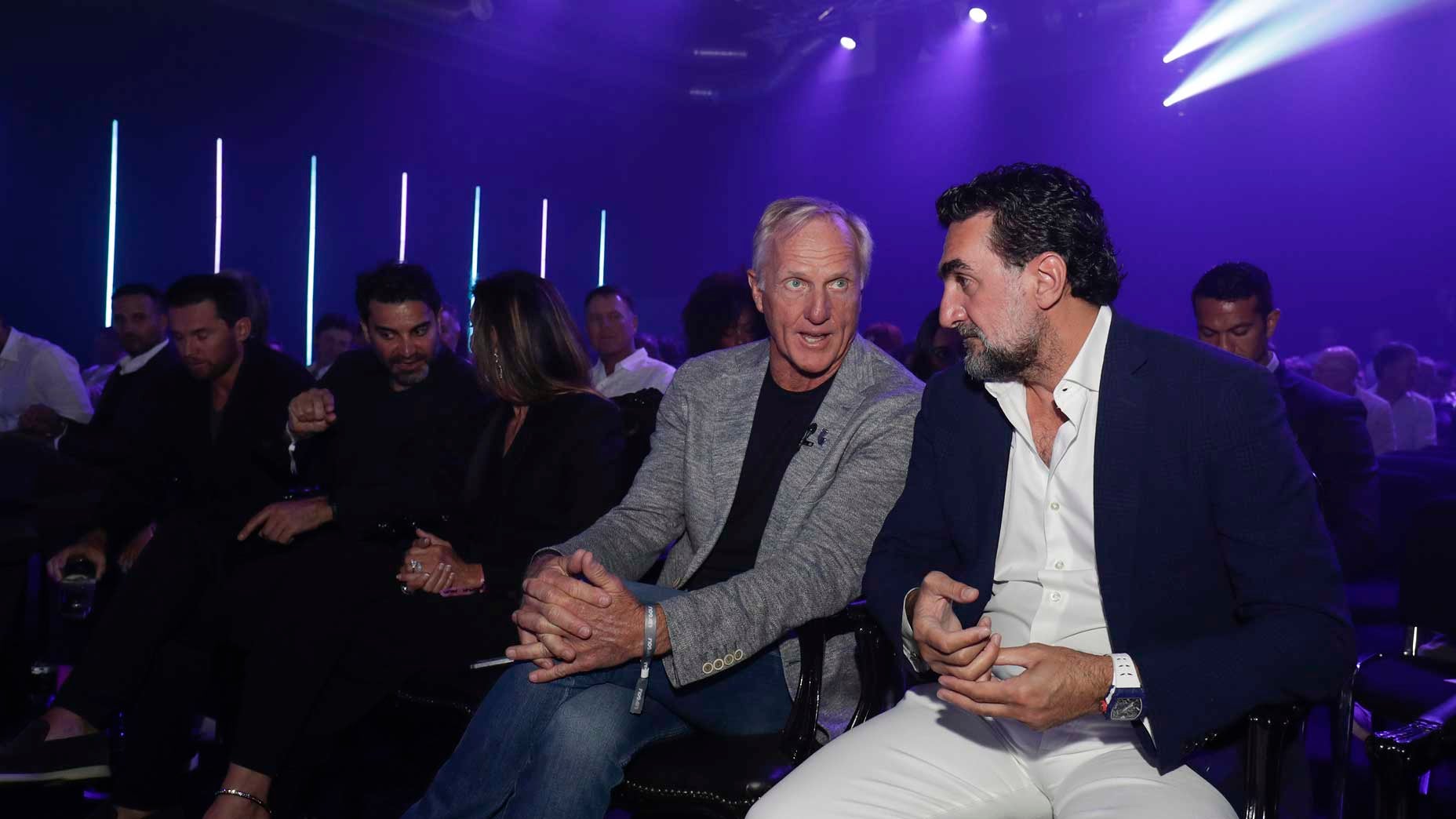
As the crowd settled into position and those royal seats were filled, the lights quickly dimmed, just like in a movie theater. Showtime. Gigantic rectangular screens lit up at the front of the room, beaming out a 110-second mix of strobe lights, colors, beats, optical illusions, avatar golfers, tees flying at you, and a sequence of five flashing words.
Whatever
you do
don’t
blink.
You didn’t want to. At any second the room was completely dark, and the next completely illuminated. From the back of the room, the strobes silhouetted the still noggins of the crowd. Grey, white, and black golf balls clanked into each other to fit in the screen frame, as if they were ping pong balls in a lottery machine. LIV may have goofed on The 19th Hole, but the graphics team was crushing it.
“Isn’t this amazing?” Jane MacNeille asked, nudging me with her elbow. I hadn’t given an ounce of reaction yet. It was amazing. After months of anguish and indecision, this was a sudden dose of reality, and I truly felt the hype. Ten days earlier, I didn’t even know who would play in this tournament, and suddenly it felt like a marquee event. If I had woken up from a two-year coma to find captain Dustin Johnson drafting teammates into a cash-soaked shootout in the middle of major championship season, I would have thought, Holy s—t, golf got really cool. Only I hadn’t been comatose for two years. I knew all the context for why this was in front of me. It’s flashy as hell, and it has some uncertain intentions.
When the video lifted, two hosts took the stage: Kirsty Gallacher and Shane O’Donoghue. A carefully worded script had been loaded onto teleprompters in front of them, but their main job was guiding the draft to fit the “Golf, But Louder” motto. Gallacher started quickly, telling the audience that, yes, it is okay to get up out of your seat and be loud during the draft. They wanted to inspire the sort of viral reactions you see from New York Knicks fans during the NBA Draft. The audience didn’t really know what to do. The loudest anyone got all night was intermittent shouts from a well-lubricated member of Wade Ormsby’s team. “Kah-mon Wade!”
Before any captains were announced or selections were made, an original, 23-page run-of-show called for a speech from Yasir Al-Rumayyan, the most important man in the room. Three-hundred and forty-eight words were spelled out on the document, including these two sentences of interest:
“From the outset, we focused on enhancing golf’s ecosystem. This isn’t nor has ever been an aggressive takeover bid of world golf.”
The word “ecosystem” would come to dominate legal documents and statements from governing bodies all summer long. The second sentence, I felt, was one that would have found its way into lawsuits, too, had it been delivered. Whether or not this was a takeover bid of world golf, it was definitely aggressive. But for some reason, Al-Rumayyan’s speech was removed from the script and scribbled out in red ink. Instead, Norman took the stage, delivering his own speech exactly as it was spelled out in the run of show. “The future of golf starts Thursday,” Norman said to the packed room. “And there’s no looking back.”
I wondered how much bloviating I would have to parse through. Norman was laying it on thick, gushing about the innovation he was bringing to the sport and labeling the players and caddies the “first-movers at this historic moment in time.” At the end he thanked his Saudi supporters and told the entire room, “LIV does not exist without any of you.” Then he stuck his fists out to each side and raised them in the air, flexing his biceps like a gladiator and letting out an awkward cry: “LET’S GOOO!”
Let’s go, indeed. Twelve of the best golfers in the world had been standing at each side of the room, split into lines of six, now partially illuminated by the glow from the screens. These were your team captains, standing in reverse order of their world ranking and in the order by which they would make selections. First on the right was Graeme McDowell, the 2010 U.S. Open champion, and first on the left was Peter Uihlein, the 2010 U.S. Amateur champion who had struggled to establish himself atop the pro game. Fourth in line along the right side stood Phil Mickelson, in the flesh. Finally, I felt it. That anticipatory, only-three-hundred-people-are-seeing-this kind of eagerness. I don’t know why it felt like a surprise to see him — he had been announced as a final addition to the field just a day earlier — but part of it was certainly because he was making his first appearance since taking a voluntary leave of absence after his true motives for joining LIV were put on full display in February. Mickelson wore black pants and a black leather jacket, his long hair slicked back. After 30 years of being clean-shaven in the public eye, he sported a prickly beard. This was a different Mickelson.

As soon as Gallacher began introducing Mickelson, phones shot into the air. Whether it was capturing Phil for the first time in months like a bunch of thirsty paparazzi, seizing a pic of peculiar golf history, or just grabbing a photo to remember the night by, this was the moment everyone cared about.
“Now please welcome to the stage HyFlyers GC,” Gallacher announced. “With a name like HyFlyers, their identity has to reflect a team in flight. Powered by its winged logo, this team will be hoping they live up to their name and soar above the competition at the LIV Golf Invitationals.”
(Mickelson’s team was promised to fly high. Fireballs GC was called “anarchic” and for younger golf fans. Dustin Johnson’s 4 Aces were billed as golf ’s greatest magic trick. With a completely blank slate to work from, LIV chose its team names like it named its bar, in the cheesiest manner possible.)
As Mickelson climbed up on stage and posed for photos with Norman, a trend started to reveal itself. Gallacher introduced him with only one set of credentials: six major championships, the most of any LIV golfer. No one in this room had done more on the PGA Tour — or done more for the Tour — than Mickelson, who won 45 times in the last three decades, good for eighth best all time. But you weren’t going to hear those two words uttered during this description. In fact, you weren’t going to hear “PGA Tour” mentioned once all night. And you would have to strain to find those words written into any formal communication from LIV Golf all year long (that is, until litigation between the two brands began). LIV was not going to imply any added relevance to the Tour by citing it during its own proudest moments. So on draft night, Sergio García was labeled as “a major champion with 36 career victories.” Ian Poulter’s career was introduced as “19 professional victories.”
“That’s a cool lookin’ look for Phil,” O’Donoghue said as Mickelson got comfy at a desk on the far left side of the room. “It’s his birthday next week, folks. June 16, and he shares it with Old Tom Morris. How about that for a little bit of history?”
Dozens of video producers scurried about, capturing the content we’d see on YouTube and Twitter the next day. In front of each of the captains was an iPad with team names and logos on the screen. It was impressive tech, in a way, that Mickelson could scroll through the remaining players available while García made a selection 50 yards from him. Suspenseful music played over the speakers as captains were given exactly 54 seconds to lock each selection, part of LIV’s undying commitment to the roman numeral LIV. Only most captains didn’t use the iPads. A production staffer wearing a headset chased around the room with a physical list of players on a clipboard. Captains pointed to the names on the list, and soon enough that name was read across the teleprompters in front of Gallacher and O’Donoghue. On paper, that’s how a draft works — a genuine draft. But this wasn’t a totally genuine draft.
In front of Louis Oosthuizen were two things: a list of players available and a reminder: Charl Schwartzel is already on your team. He is your second-round pick. Branden Grace is also on your team. He is your third-round pick. When the hosts pan to you for those picks, please — please! — don’t select anyone else.

Earlier in the day information trickled out on social media that there were really only 31 players available to be drafted, not 36, as the format had promised. Oosthuizen’s Stinger GC was basically already assembled, pre-arranged by South African friends who wanted to play together. Screw the draft. The same went for Ian Poulter’s Majesticks team, which was assembled again by friends who wanted to play together — screw the draft. Sam Horsfield, Lee Westwood, and Laurie Canter were already locked in on Poulter’s team, so he didn’t have to make a single pick. This is, of course, how you end up with an unknown like Hennie Du Plessis as one of the first 12 players chosen. Chaos actually arrived much sooner than that. McDowell snatched Bernd Wiesberger with the first pick, and then after a bit of deliberation, Uihlein selected Hideto Tanihara. It was a sound pick, by all accounts. Only it quickly became clear that Kevin Na had expected Tanihara to still be available at No. 10. Na clearly wanted to assemble a team of players of Asian descent and had communicated to the other captains that he wanted the Japanese Tanihara to join his Iron Heads. Uihlein didn’t get the memo.
Players glanced awkwardly from desk to desk. Uihelin was laughing and Na was panicking. A long, pregnant pause was maintained by the two hosts. Everyone in the room was confused. “There’s a bit of deliberation going on,” O’Donoghue said. “We’re not entirely certain what happened with the computer. But these things happen, folks. This is LIV Golf, this is live TV, it’s live golf. And so if something has to change, we’ll figure it out.” He was right, something did have to change: the second overall pick.
As innocent as this was, the ordeal served as LIV Golf ’s first hiccup with a draft it was marketing as totally genuine. Na ended up selecting Richard Bland with his second-round pick, 15th overall, and by the time the teams were announced to the public, the first-round snafu had been rectified. The first LIV Golf trade had also taken place: Tanihara for Bland, straight up. Nothing else. Another seat-of-their-pants adjustment.
Most of the captains’ intentions had already been widely known to LIV staffers. MacNeille, sitting next to me, already knew Sergio García was going to draft Spanish amateur David Puig. It was clear Talor Gooch was going to select Hudson Swafford, rising to bear-hug his buddy after taking him ninth. The most genuine part of the draft may have come from Dustin Johnson, who admitted he knew so few players in the room that he was using a cheat sheet made for him by an equipment rep from TaylorMade. With plenty of partnerships roughly in place, and the frivolity of whether Mickelson would choose Chase Koepka or Andy Ogletree, the rest of the draft went off without a hitch. The crowd was never going to be anxious about who might earn the draft rights to Sadom Kaewkanjana, so it went by rather quietly, too. Each pick earned the requisite amount of applause, waved on stage for a few seconds, and then went to sit next to their captain. The graphics were great, the production was great, and the milestone for LIV felt very real. The hosts did their job.
“They have built it, and they have come,” O’Donoghue said when it was over, a perfectly hokey sign-off for the night. Every player and team was called on stage for photos with Norman, who passed out logoed hats for each of the newfangled franchises. Some captains conducted interviews with producers as the after-party started in spirit. Wait staff began circling the room with gin-based cocktails made special for the event. Turk Pettit yanked his new Niblicks GC ball cap down tight around his head and posed for a pic with his girlfriend. The photo would later find its way to Instagram with the caption, “Big Draft Energy.”
“I like that hat, baby,” McDowell said to his 23-year-old, baby-faced teammate. “It looks good.”
“Yes sir,” Pettit replied with a smile. “All week.”
All week, for sure, but not all year. Not all summer. As novel as this draft was, it had meaning, but it didn’t have weight. LIV announced that it would have drafts at each of its events, which greatly underpinned how “good” Pettit looked in Niblicks green. If this was golf imitating other sports, the value of signing young Pettit to a franchise was nonexistent. His time on the Niblicks lasted all of four days, as he would become a member of Cleeks GC at the second LIV event (and even change teams again before the third event). This league was adjusting on the fly, but should I blame them? How much should I let expectations impact my view on things? Did I need to hold it against them? Did they have to thump their chest so much?
Another sign came from Richard Marsh, a man I met earlier in the night. On paper, or rather, LinkedIn, Marsh was the group strategy director for Performance 54, a golf marketing company. In reality, he was introduced to me as one of the lead contract negotiators, and despite hiding behind a director title for P54, he was one of the top straws stirring the drink for LIV. Marsh used to be the CCO of World Golf Group, who first launched the idea of a rival tour years ago. It didn’t happen then, but now it was—and it was hard to imagine there was a busier phone than his over the last two months. “You must not be getting much sleep these past few weeks,” I said, trying to make the kind of small talk that incites some juicy detail. “Nope,” he said, stealing a sip from his cocktail. “This is just the beginning.”
I met Majed Al Souror, too, the head of the Saudi Golf Federation. Like Dustin Johnson, he seemed happy to chat and shake hands, right until the moment I explained what I did for work. I asked him about Newcastle’s prospects in the Premier League now that he and the PIF were involved. “Just wait until next year,” he said, before turning to another conversation.
I met James Costigan that night, LIV’s head of event security, a gruff man who had been plucked from Augusta National. This sent my curiosity sky high. You don’t leave Augusta National unless you’ve got one helluva job offer. I guess that’s what this was. Costigan was just one of many industry veterans LIV had recruited to join its enterprise. Slugger White, who retired from the PGA Tour after 40 years as a Rules official, jumped back into action to do the same job for LIV. I didn’t want to guess how many digits were in his salary. He scooped up a fellow ex-Tour official and began assembling a staff with others from the USGA and PGA of America sections. Ari Fleischer, former White House press secretary, was brought on exclusively as a consultant to aid LIV with its early, thorny press conferences.
Seeing this all-star staff with my own eyes, LIV started to look like a jigsaw puzzle slowly shifting into order. Even more clarity regarding LIV’s intentions would arrive in the following days. After posing for a few photos, Mickelson received one last spurt of media training that night before heading off to bed. In 12 hours, he would face the press for the first time in more than four months.
The above is an excerpt adapted from the new book, ‘Searching in St. Andrews’. It is reprinted here with the permission of Triumph Books.



